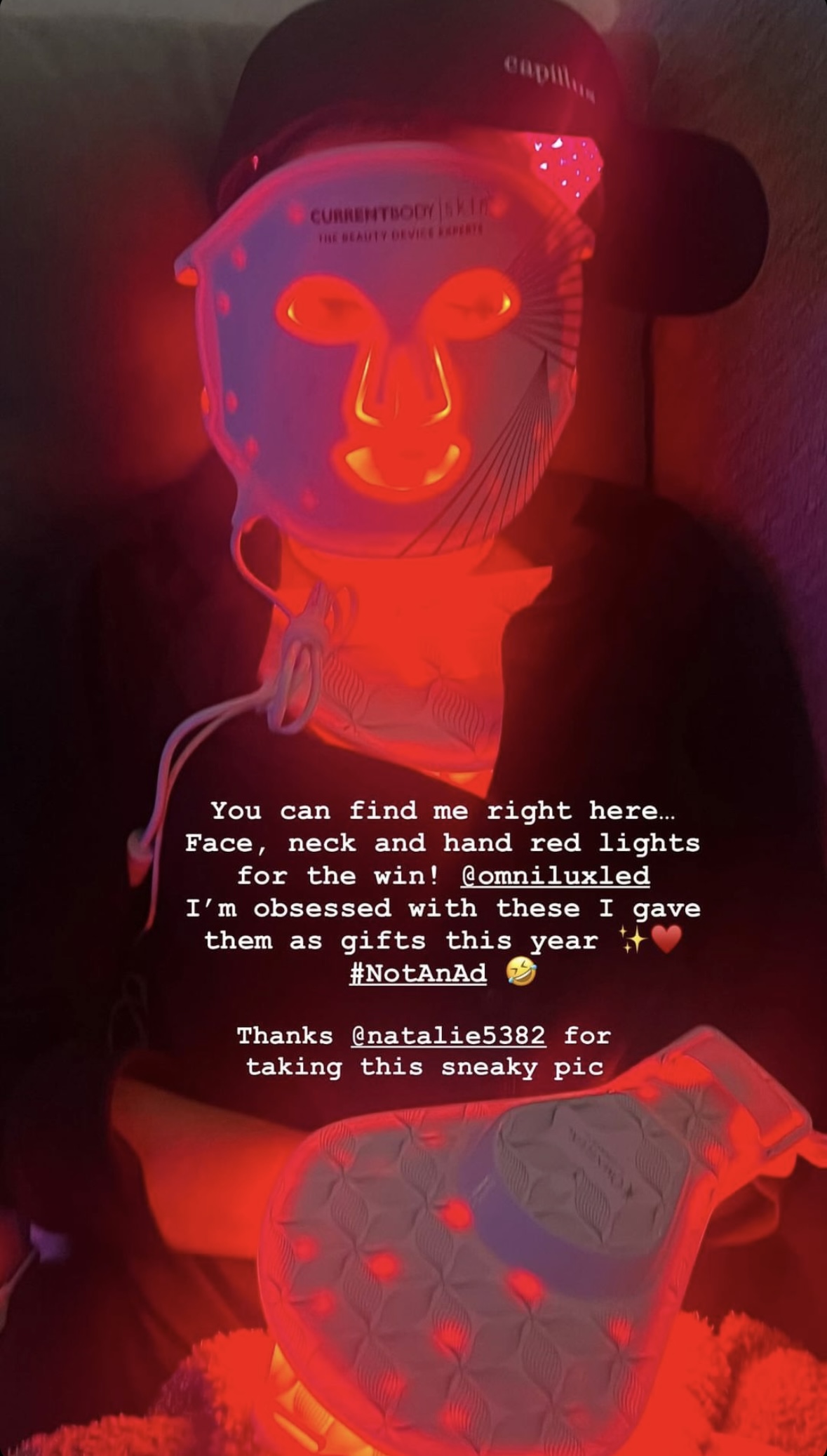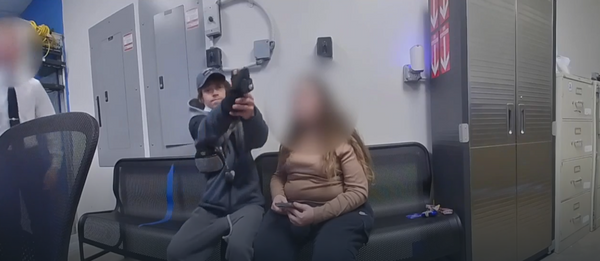
I've recently started using at-home LED light therapy masks (the collagen-boosting benefits and acne-fighting abilities got me hooked), but celebrities like Kim Kardashian have been obsessed with this beauty tech for years now. Sure, she gets facials, salmon sperm injections, and has regular consultations with her dermatologists and aestheticians, but red light therapy appears to be a cornerstone of her skincare routine.
Proof of her fandom: for Christmas 2023, she gifted a slew of her loved ones with LED light therapy masks for the face, neck and hands from brands like CurrentBody and Omnilux. "I'm obsessed with these. I gave them as gifts this year," she wrote on a past Instagram story and even went as far as to mention her post wasn't an ad, proof that she's a genuine fan.
While it's great that Kim K. loves some beauty downtime and has the funds to share LED tech with her friends, there are a few things to know before shelling out your own cash to get your hands on a pricey at-home LED light therapy device. For starters, you'll want to make sure you buy one specifically tailored to your skin concerns. "LED light therapy has become a trusted option for improving both skin health and overall wellness," says Mona Foad, M.D., MHS, board-certified dermatologist at MONA Dermatology. "It uses specific wavelengths of light to gently address concerns like breakouts, redness, and signs of aging, while also supporting collagen production and skin healing."
A Kardashian-loved beauty recommendation is nice, but it's not everything. Below, expert dermatologists spill the details on what makes LED light therapy so effective, how these at-home tools compare to in-office treatments, how to set realistic skin expectations, and more.

Kim's Favorite LED Light Therapy Tools
What Are the Benefits of LED Therapy?
LED light therapy offers various benefits for the skin, depending on the wavelength and type of light used. Yes, there's more than just red light, and yes, it does make a difference.
"Light emitting diode (LED) treatments use different wavelengths in the visible light and near infrared spectrum to achieve various effects, such as the reduction of inflammation, treatment of acne and breakouts, accelerate wound healing, stimulate hair growth and improve fine lines and wrinkles," explains Morayo Adisa, M.D. and Medical Director Dermatology Physicians, Chicago.
Here, Ashley Magovern, board-certified dermatologist and Dermstore Medical Advisory Board member, helps break down the benefits of each color.
Red Light (630–660 nm)
- Boosts collagen and elastin production
- Reduces fine lines and wrinkles
- Improves circulation and skin texture
- Calms inflammation—great for rosacea or sensitive skin
Blue Light (405–420 nm)
- Kills Cutibacterium acnes (the bacteria linked to acne)
- Reduces active breakouts
- Often combined with red light to calm inflammation post-acne
Near-Infrared (810–850+ nm)
- Penetrates deeper than red light
- Targets muscle, joint, and even scalp tissues
- Used for healing, hair regrowth, and pain reduction
- Improves mitochondrial health, the powerhouse of all cells
What Are the Downsides of LED Therapy?
LED light therapy is a fan favorite for many reasons. "Regular sessions can lead to clearer skin, smoother texture, and a more even tone," says Dendy Engelman, M.D., a board-certified cosmetic dermatologist and Mohs surgeon at Shafer Clinic in New York City. "It’s a non-invasive, pain-free option that supports long-term skin health with minimal risk or downtime."
However, there are still some minor drawbacks to be aware of. "Overuse or misusing devices can lead to dryness, irritation, or increased sensitivity, especially in people with reactive skin," says Dr. Engelman. "It also requires consistency and patience—results build gradually over time, not overnight." Additionally, not all at-home devices are created equal; lower-quality tools may not deliver the correct wavelengths or intensity required for genuine skin benefits.
Should I Use an LED Mask?
LED light therapy is praised for being generally non-invasive and gentle, making it a great option for many people seeking firmer, clearer skin. However, there are a few instances where people should steer clear.
Dr. Foad explains that anyone with a history of photosensitivity, whether due to medical conditions such as lupus or medications that increase light sensitivity, such as doxycycline, should speak with their healthcare provider before starting treatment. It is also recommended that pregnant individuals consult their doctor before treatment (research in that area is limited). People with certain skin cancers or active infections should avoid light therapy until they've consulted with a dermatologist. Dr. Magovern adds that "people with severe eye conditions or light-triggered seizures" should also take precautions with light therapy tools."
While red light therapy is gentle, making sure it’s safe for your unique situation is always the best first step.
Is At-Home Light Therapy as Good as In-Office Light Therapy?
The short answer is that at-home devices do not have the same strength as in-office treatments. However, that doesn't mean an at-home device isn't worth it. They just require more patience and consistency.
"At-home LED masks or wands are less powerful than in-office devices, which is why they’re safe for daily use," says Dr. Magovern. "But they can absolutely work—with consistent use. I find that people start to abandon them after the initial excitement wears off."
In-office treatments—frequently under brand names like Celluma or LightStim Pro—are more powerful, penetrate deeper, and offer "stronger clinical results." That being said, both types of treatments can be used synergistically—at-home devices can help extend the results of in-office treatments.
When Will I Notice Results From At-Home LED Masks?
With at-home devices, patience is key. Dr. Engelman explains that "typically, noticeable improvements from LED light therapy start to appear after about four to six weeks of consistent use." Most people do treatments three to five times per week, with sessions lasting 10 to 20 minutes. Results build gradually as the light stimulates collagen production and reduces inflammation over time, she adds.
Dr. Adisa also shares that on average, "it takes about four weeks to see a difference with acne treatments and four to 16 weeks for lines and wrinkles."
What Is the Main Difference Between Currentbody, Omnilux, and Shark At-Home LED Masks?
When it boils down to different at-home devices, choosing one that is FDA-approved, within your budget, and targets your specific concerns is key. The Big Three players: CurrentBody, Omnilux, and Shark Beauty.
"Both CurrentBody and Omnilux are FDA-approved red and near infrared light-emitting devices that are both for anti-aging, and are flexible silicone," she says. "They differ slightly in cost (with Omnilux slightly more than CurrentBody), and in power with Omnilux greater than CurrentBody."
Dr. Foad also shares some insight into Shark Beauty, a newer LED light therapy mask on the market. "Shark Beauty combines light therapy with other skincare features [like cryotherapy], making it an appealing option for those seeking a multifunctional device," she says. However, the light intensity may not be as focused as that of some other brands.
Kim K. Has Her Faves, but Here are Some Other Great LED Light Tools
Why Trust Marie Claire
For more than 30 years, Marie Claire has been an internationally recognized destination for news, fashion, and beauty trends, investigative packages, and more. When it comes to the products Marie Claire recommends, we take your faith in us seriously. Every product that we feature comes personally recommended by a Marie Claire writer or editor, or by an expert we’ve spoken to firsthand.







